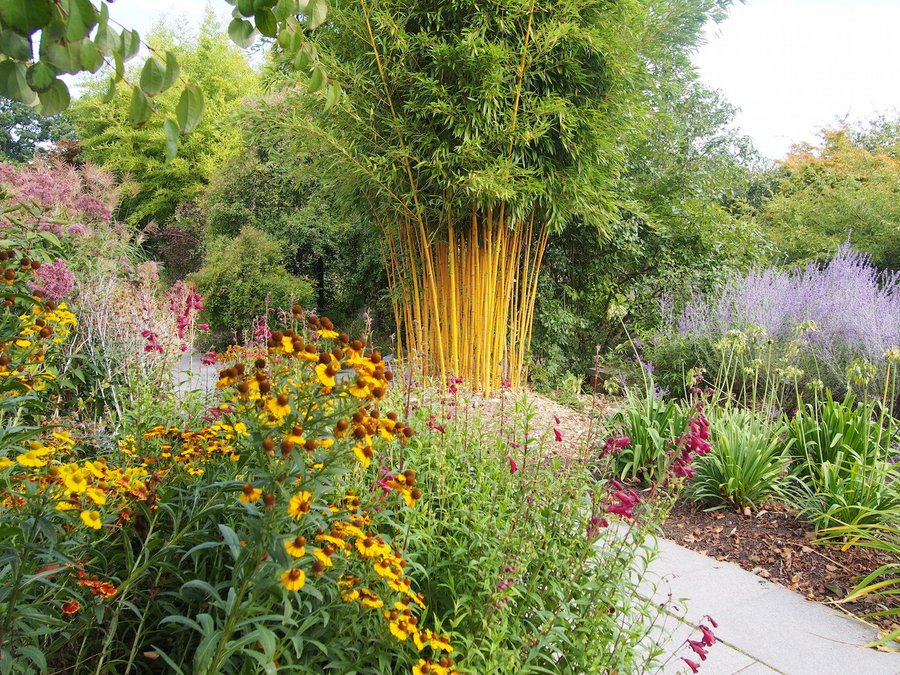Yellow cane bamboo (Phyllostachys aureosulcata f. aureocaulis) is a spectacular bamboo that closely resembles the Golden Chinese Timber Bamboo (Phyllostachys vivax aureosulcata).
The two running bamboo plants have striking yellow stems with green stripes.
Find out about this outstanding bamboo as compared to its cousin yellow bamboo plants.
 |
| Image credit: Val Bradley @valgardening/Twitter - (Phyllostachys aureosulcata f. aureocaulis) |
Garden features
- Site: Grows well in full sun and partial shade.
- Soil: Well-drained chalk and loam soil, moist.
- Uses: Excellent for hedging, screening or large pots and containers. Do not do well in windy sites.
- Winterhardiness: Hardy to – 15 degrees Celsius.
- Height: 6 – 8m.
- Spread: Running bamboo, allow space to spread or contain in large pots.
- Foliage: Evergreen.
- Culm colour: Striking Golden yellow, green stripes on rims.
Yellow Cane Bamboo vs. Golden Chinese Timber Bamboo
The key features that set these two Phyllostachys apart are the thickness of the culms and minute colour variations, including the shape, size and height.
Predominantly, the Yellow Cane Bamboo had sturdy, thick and compacted internodes with larger green stripes, whereas the Golden Chinese Timber Bamboo has elongated internodes, slender green stripes and is generally taller.
Read about the Golden Chinese Timber Bamboo (Phyllostachys vivax aureosulcata)
 |
| STEM of a Golden Chinese Timber Bamboo (Phyllostachys vivax aureosulcata) - CLOSE UP |
Grow Yellow cane bamboo (Phyllostachys aureosulcata f. aureocaulis)
Yellow cane bamboo (Phyllostachys aureosulcata f. aureocaulis) is a tall running bamboo that can reach an average of 8 metres in height.
The lush evergreen leaves contrast beautifully with the golden yellow culms forming an impenetrable hedge.
Invasive, the Yellow Cane Bamboo need space to grow.
Alternatively surround the roots with the root barrier to restrict the rhizomes from spreading.
Grow Yellow cane bamboo (Phyllostachys aureosulcata f. aureocaulis) where there is enough space, away from strong wind, or in large pots and containers to contain its spreading.
Mature Yellow Cane Bamboo will thrive in well-drained loamy soil with high moisture and nutrient contents. Like most bamboo plants in the UK, they do not like compacted dry soils.
Although the old bamboo will thrive in most UK conditions, it will occasionally need feed and water. In addition, regular checks are vital to containing the invasive rhizomes from spreading.
Care for new bamboo plants
Although the Golden Grove Bamboos are low-maintenance plants, the new growth will require care and attention.
The slugs adore the tender new growths, they can wipe off the fresh leaves in one visit if left unprotected.
Protect the new growths by adding Slug and Snail Killer, if you are propagating bamboo plants from the rhizome or culm cuttings, or planting a recent purchase.
Maintain Yellow cane bamboo (Phyllostachys aureosulcata f. aureocaulis)
The Yellow Cane Bamboo Plants are large tall plants.
The bamboos' horizontal rhizomes can spread to an average of 4m if left unchecked. It is best to give it space to grow.
Alternatively surround the plants with thick Root Barriers.
Better to grow them where there is enough space, away from strong wind. Grow in large pots and containers to contain its spreading.
So, now you should have an idea about the stunning Golden Chinese Timber Bamboo (Phyllostachys vivax aureosulcata) and Yellow cane bamboo (Phyllostachys aureosulcata f. aureocaulis.




